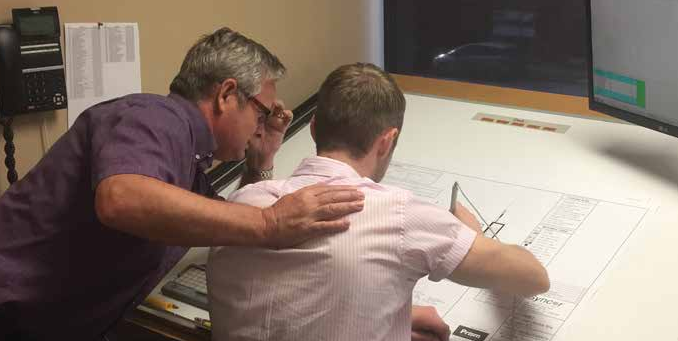
The notion that an estimate can never be perfect is what separates the schools of estimation and accounting. Estimating and the costs associated with the final numbers result from making judgments based on past experience, and in that frame of mind, the variables are never the same.
The estimator has certain responsibilities for preparing the bid. Estimated materials and equipment costs are based upon “takeoff” quantities to be installed, plus tax and cartage. Labor costs are estimated man hours based on past experience times rate of pay, plus stat and vacation pay, E.I., C.P.P., W.C.B., Union charges (pension, medical, dental, other union funds), association dues, safety fund allowances, insurances, payroll financing, cellphone / pager, site expenses, metro travel expenses, and administration charges (project management, superintendent, payroll administration). There are other costs to consider as well, including rentals, tool allowance, bonds, and CAD / as-built charges.
The estimated break even cost is the three above plus fixed overhead, and the estimated bid/ change order price is the break even cost plus profit and risk.
Estimators can complete their tasks manually or using a software application and there are components of each method estimators love and hate.
Manual estimating methods include stripping the drawings to create the take-off, quantifying or squaring up the items taken off, and creating extensions—multiplying the quantified items above by both the materials cost of each item and the labor
units chosen for that particular project.
Totalling up means adding like items, and multiplying their cost per hour in the terms of labor items and by PST in term of materials items. Add these together along with sub-trade prices, room and board, travel, freight, supervision, and bonding charges to arrive at the total before adding mark-up—overhead, profit, and risk.
Computerized estimating using software applications is a newer concept, but one that is gaining traction in all facets of the construction industry. Because software systems are automated, they helps address the lack of specialized estimation training available to workers in the industry. Using computerized estimating relieves time pressures on job sites, relieves corporate profit pressures, and helps reduce manual errors in quantification and addition. Software allows for a more professional presentation and breakout pricing is easier to achieve.
Computerized systems can also help alleviate some of the associated with change orders. Change orders are disruptive and annoying and contractors must receive fair compensation covering all the costs incurred in performing the change. Be realistic but ensure you have everything covered with an added risk factor. Companies very rarely allow enough for disruptions to the project that a change causes.
Estimators put as accurate a bid together as they can, allowing risk money / hours for areas of the drawings / specs that are not cleared up prior to closing. The estimate (accurate guess) acts as a budget for the operations manager, project manager, project coordinator, outside supervisor, site foreman, the field crews, the shop supervisor, the shop foreman, and the fabricators to work from.
Cost certainty is never attainable because of the multitude of job variables.
The materials, sub-trades, supplier’s items, and the shop labor are easier to predict as these costs are fairly controlled. Field performance varies greatly from foreman to foreman, crew to crew, PM to PM, customer to customer, and between general site conditions, not to mention general contractor and developer differences. The most successful projects are usually ones in which the field labor meets or is below the estimate.
The estimator has other responsibilities beyond creating the bid. He or she is responsible for sales duties associated with estimating including liaising with customers, engineers, and owners; making the company aware of present and upcoming
market conditions; and, through contacts, searching out select tender opportunities, and helping negotiate favorable purchase orders.
The brass tacks estimating responsibilities begin with obtaining drawings, bidding and following up tenders, and tracking bids and adjusting them accordingly to ensure we are getting the maximum available profits through an appropriate market.
Estimators also liaise with sub-trades, suppliers, customers, and engineers; prepare project budgets; and, place purchase orders with sub-trades and suppliers. It is up to them to review the project with the construction team – specifically the project manager – during the construction phase as required and quote any changes that may occur.
They must get to know the competition and understand when they are flush with work, in need of work, and when they have way too much work on the go because all of these factors will affect the available markup on the project. In response to these and other fluctuations, the estimator must rework the estimating data as the need arises (ie: new machinery is purchased increasing productivity, materials pricing changes); and, upon completion, he or she must perform reviews of completed contracts to ensure the estimated figures match the actual. Understanding why they don’t and applying this knowledge is critical to the success of future bids on similar projects.
A quality bid takes into account the company’s need for each specific project it is bidding on, the company’s capabilities (is the project a good fit?), the capabilities of the mechanical contractor, the probable markup, the customer’s capability to promptly pay his bills, the known site conditions, the condition of the market place, the company’s ability to properly perform the work, the schedule, any outside influences, banking pressures, bonding capabilities, capacity issues, the company’s corporate goals/budgets for the year, any personal connections that may be affected performing the work, and, of course, the availability of time (does the estimator have enough time to put together this bid in a manner that gives the company the best opportunity to secure the project?).
Estimating is not just stripping off drawings and sending quotes out to customers hoping to land a project or two. An estimator takes years to learn and perfect his or her craft. Industry connections with a company’s competition, its customers, and the engineering community will assist a quality estimator with performing his very important piece of the construction team’s puzzle with the greatest proficiency. Estimating is a passion for perfection that can never be mastered. Estimates, after all, are only educated budgets with targets for a company’s construction team to attempt to achieve.
Estimating can be a very rewarding profession. The thrill of compiling an accurate take-off together with industry intel that leads to a quality quote can be exhilarating. But, generally, an estimator should strive for a 20 percent success rate. Any more than that and the bids are probably leaving some profit points on the table. Any less and he or she is probably not spending the time required to search out and eliminate the risk factors involved that force a company to add risk dollars.
Be aware, though, although an estimator may fall in love with the project and the bid he has put together, 80 percent of the time he is not going to be successful. Estimators should be passionate and disappointed if they do not secure the bid they just poured their heart and soul into, but they can’t take losing one project too seriously. There will always be another and the good quality work will flow towards those who do their due diligence and always strive to put out the best bid they can.
If you live by that mantra you will be successful in estimating. Patience is surely a virtue with this profession.



